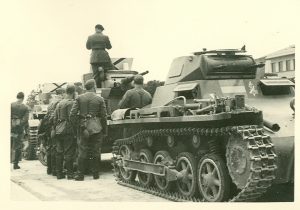Today a nice photo from the time of the Spanish Civil War.
Recognizable here is a group of three tanks consisting of a Pz.Kpfw. I Ausf. A and two T-26 model 1935/36.
The vehicles obviously belong to a unit of the „Nationalists“ or to the so-called „Legion Condor“ („Panzerabteilung „Drohne” „).
The opposing „Nationalists“ and „Republicans“ was supported at the beginning of the Spanish Civil War, among others, by countries such as Germany and Russia with arms.
At the beginning of October 1936, Germany delivered about 40 pieces Pz.Kpfw. I Ausf.A, and about 20 pieces of Ausf.B. (until 1938 a total of about 45 Ausf.A and 77 Ausf.B).

Russia, on the other hand, initially supplied about 50 T-26s (totaling about 280 units by 1938) to the Republicans.
The relatively good firepower of the Soviet T-26 on the part of the „Republicans“ were predominantly opposite the Pz.Kpfw. I and L3/33 / L3/35 supplied by Germany and Italy to the „Nationalists“.
By the end of the war about 178 T-26s had been captured by the „Nationalists“, of which about 50 were supposed to have been used again.
The two in the picture behind the Pz.Kpfw.I recognizable T-26, are obviously such captured vehicles.
They already bear the common mark, the Spanish flag (red, yellow, red) on the cannon cover and on the turret roof recognizable by the opened door hatches, the black crosses mounted on a white background. These served as a detection signal for the own air force.
The visible in the foreground Pz.Kpfw. I Ausf.A carries the Spanish flag as a marker on the front plate to the right of the driver’s view hatch. In addition, here is a very nice emblem of the tank unit in white color recognizable. This emblem evidently consists of a crossed musket and crossbow and a vertical halberd.
Noteworthy on Pz.Kpfw. I is the heavily used and worn front wheel (rubber lining) of the track drive. This probably shows clearly that no new vehicles, but already used vehicles have been delivered to the „Nationalists“.
The pictured german soldiers of an infantry unit wear the usual for this time uniformation of the „Legion Condor“. The soldier at the turret of the middle T-26 wears uniforms usual for members of a tank unit, in particular recognizable by the black beret.
At present, no details can be given as to the exact unit and the time of the recording.
Whether this is a training unit or already a fighting unit is also not known to us.
Supplementary instructions and information are always welcome to us as well as in the photos shown above.
_____________________________________________________________________
Heute mal ein schönes Foto aus der Zeit des spanischen Bürgerkriegs.
Erkennbar ist hier eine Gruppe von drei Panzer bestehend aus einem Pz.Kpfw. I Ausf. A und zwei T-26 Modell 1935/36.
Die Fahrzeuge gehören offensichtlich zu einer Einheit der “Nationalisten” bzw. zur sogenannten “Legion Condor” (“Panzerabteilung “Drohne””).

Die sich verfeindet gegenüber stehenden “Nationalisten” und “Republikaner” wurde zu Beginn des spanischen Bürgerkrieges unter anderem durch Länder wie Deutschland und Russland mit Waffenlieferungen unterstützt.
Deutschland lieferte hierbei zu Beginn im Oktober 1936 etwa 40 Stück Pz.Kpfw. I Ausf.A, und etwa 20 Stück der Ausf.B. (bis 1938 insgesamt etwa 45 Ausf.A und 77 Ausf.B).
Russland lieferte dagegen zu Beginn etwa 50 Stück T-26 (bis 1938 insgesamt etwa 280 Stück) an die “Republikaner”.
Der vergleichsweise guten Feuerkraft des sowjetischen T-26 auf Seiten der “Republikaner” standen überwiegend die von Deutschland und Italien an die “Nationalisten” gelieferten Pz.Kpfw. I und L3/33 / L3/35 gegenüber.
Es sollen bis Kriegsende etwa 178 T-26 durch die “Nationalisten” erbeutet worden sein, wovon etwa 50 Stück wieder verwendet worden sein sollen.
Die beiden im Bild hinter dem Pz.Kpfw.I erkennbaren T-26, sind offensichtlich solche erbeuteten Fahrzeuge.
Sie tragen bereits die gängige Markierung, der spanischen Flagge (rot, gelb, rot) an der Kanonenblende und auf dem Turmdach anhand der geöffneten Turmluken erkennbar, die auf weißem Untergrund angebrachten schwarzen Kreuze. Diese dienten als Erkennungssignal für die eigene Luftwaffe.
Der im Vordergrund sichtbare Pz.Kpfw. I Ausf.A trägt die spanische Flagge als Markierung an der Frontplatte rechts neben dem Fahrersichtluke. Zusätzlich ist hier noch sehr schön ein Emblem der Panzereinheit in weißer Farbe erkennbar. Dieses Emblem besteht offenbar aus einer sich kreuzenden Muskete und Armbrust und einer senkrechten Hellebarde.
Beachtlich am Pz.Kpfw. I ist das stark gebrauchte und verschlissene vordere Laufrad (Gummierung) des Kettenlaufwerkes. Dies zeigt vermutlich deutlich, das keine neuwertigen, sondern bereits gebrauchte Fahrzeuge an die Nationalisten geliefert worden zu sein scheinen.
Die im Bild erkennbaren deutschen Soldaten einer Infanterieeinheit tragen, die für diese Zeit übliche Uniformierung der “Legion Condor”. Der Soldat am Turm des mittleren T-26 trägt die für Angehörige einer Panzereinheit übliche Uniformierung, insbesondere erkennbar an dem schwarzen Barett.
Zur genauen Einheit und dem Zeitpunkt der Entstehung der Aufnahme können derzeit keine Angaben gemacht werden.
Ob es sich hierbei um eine Ausbildungseinheit oder bereits um eine kämpfende Einheit handelt ist uns ebenfalls nicht bekannt.
Ergänzende Hinweise und Angaben hierzu sind uns wie auch bei den zuvor gezeigten Fotos jederzeit sehr gern willkommen.
Text made by R.A.
Copyright at bacuffz.com